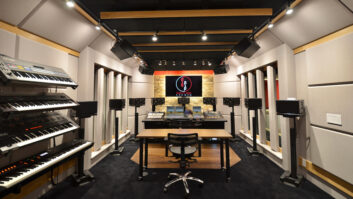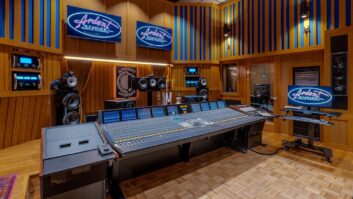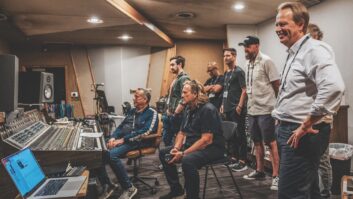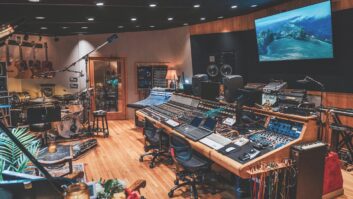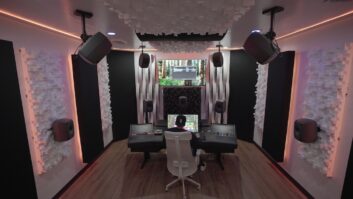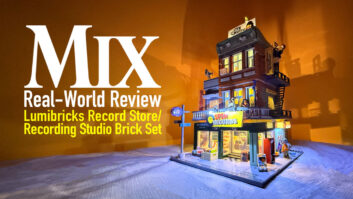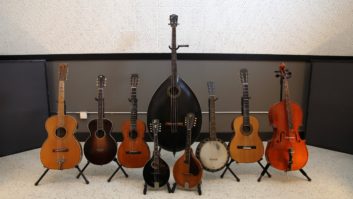MUSIC ROW NASHVILLE, TN—Now operated (again) solely by the Country Music Hall of Fame, the Historic RCA Studio B serves the public as a hands-on educational facility hosting tour groups, students and fledgling musicians. Today, visitors can learn about and record new material in the same facility that hosted such illustrious Nashville-centric legends as Eddy Arnold, Roy Orbison, Dolly Parton, Charlie Pride and Elvis Presley, among others.
Studio Manager Justin Croft has been at the facility through its transition from a “very traditional” recording facility to tourist destination to a regularly used studio again under the wing of Belmont University to its present state, all thanks to the altruism of the Mike Curb Family Foundation, combined with the mission of the Country Music Hall of Fame and Museum.

“It’s a bit of a story,” begins Croft. “We were partnered with Belmont University for about 12 years, and our other partner was the Country Music Hall of Fame. Both entities were doing things here: Belmont was having classes and we were also hosting tours and educational programming. All this is possible because of Mike Curb, whose foundation owns the building and leases it back to us for $1 a year—a totally charitable thing on his part. He’s the reason we’re here.”
As Belmont reopened Columbia Studios a block away (originally Bradley Studios), many of Belmont’s activities moved into Columbia—along with much of Historic RCA Studio B’s gear. “[Belmont] had begun to use Studio B less and less, and the Hall of Fame wanted to do more. Belmont had kept everything stocked really, really well here; we had an API console from the 1970s—originally an LA-based console on a truck—which had recorded a lot of interesting things over the years.”
Between the previous API console and the studio’s evolution of gear over the years, choosing its next mixer was a no-brainer, he said; it was API’s The Box. “Besides RCA, of course, API is really the only other manufacturer that had a console in this building during its historical period. Even some of the things RCA had designed and built were made with API parts. Our custom-built RCA board from ’71 was put together with API 2520 op-amps, API equalizers and compressors, so API was an obvious choice to consider. We still had a few historical pieces—really nice things—including compressors, Altec and Teletronix gear, but we didn’t have a board and were budget-limited.”
Besides its history with API, Historic RCA Studio B simply “needs something like The Box,” continues Croft. “The way we do our recordings are generally ‘live to two-track’ situations. We have a ‘Star for Today’ package, which is a pro-level, karaoke-style recording with tour groups. For that reason, we needed something that could run our studio loudspeakers, route our microphones, compress and add reverb: basically making a master all at once. We needed something with a robust master section, EQs, routing, auxes, sends, and all that business. The Box also has a built-in bus compressor, which you can assign on the front end, if you want.”
Other unique sessions hosted at the Historic RCA Studio B include hands-on educational opportunities as well as celebrity-studded special projects. “Our wide variety of recording here is all generally laid down live, and we don’t operate like a commercial recording studio,” says Croft. “The mission is educational, so we host school groups with a 50-60 piece orchestra, band or choir quite regularly. March through May is our busiest time of the year; we’ll see thousands of kids just in those months, doing hundreds of recordings. Then we do other kinds of things throughout the year. Then, when it meets the criteria of a “special project”—something historical in nature—we’ll host projects with Marty Stuart, Bobby Bare, and so on.”
In its heyday, Studio B was home to a range of incredible microphones. “Those were essentially scattered to the world over the years,” offers Croft, explaining that many of those classic mics disappeared into the mic lockers of various engineers while it became less of a commercial facility. “Still, though, we have a couple of RCA BK-5 vintage ribbons, a Sony Model C-500 [cardioid condenser], and a few others. The Neumanns you see in the old photos are all gone, which they really loved using here. Though those RCA mics are seen in pictures, of course, there were even more Neumann U 47s and M 50s, sometimes Sonys and EVs, too. We still have great compressors—two LA-2As, both of which are low-serial number, and an Altec 438C often used as a preamp, which was modified a bit over the years to be used mic- or line-level.”
Of key interest, shares Croft, are a few nameless boxes made by RCA that remained rarities. “They’re military-grade line-level amplifiers. Since they didn’t have a name, we started to call them the “mojo makers,” all-tube gigantic transformer pieces. We recently made an output section for them so they’re more useful for us.”
Acoustically, Historic RCA Studio B is, for lack of a better term, a unique room. Croft feels that its sonic characteristics give them an educational opportunity to show the ingenuity and creative natures of those responsible for the room’s moniker, “studio of 1,000 hits.” “Honestly, this room is kind of a shoebox,” quips Croft with a laugh. “So we cover how people like Porter [Wagoner] compensated in positioning, by hanging things from the ceiling, creating baffling, etc. Through this, we provide visitors a bit of the evolution of the recording studio. Whether it’s a tour or one of our programs, people always seem to get excited about where instruments sat during some of the legendary recordings made here. We share those—where the piano was, where the drums were, and the true sweet spot on the floor where vocals were cut. We ask students and visitors to step into the spot to hear it, which is always fun.”
In our modern recording world, where most everyone can easily have a “studio” in their laptops, API’s The Box helps visitors understand how Music City’s most popular exports were captured out of the box. Croft confesses that the appearance, the look, of a console is part of “the reason to have a console to begin with. We could make it with a rack of preamps and a patch bay. But having The Box here, we can have students into the control room and give them a basic idea of signal flow, making it something easy to understand.”
